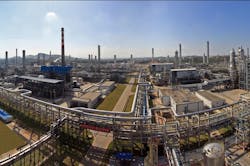Aramco renews focus on Chinese downstream operations, relationships
Saudi Aramco has entered agreements to deepen relationships with its existing Chinese joint-venture partners to expand downstream operations in China, plans which include revival of a previously announced project involving construction of a grassroots integrated refining and petrochemical complex in northeast China.
On Mar. 10, Aramco confirmed it has taken final investment decision (FID) to participate with partners North Huajin Chemical Industries Group Corp. (NHCIG) and Panjin Xincheng Industrial Group Co. Ltd. (PXIG) to advance development of their joint venture Huajin Aramco Petrochemical Co.’s (HAPCO) proposed 300,000-b/d refining and ethylene-based steam cracking complex to be built in Panjin City, Liaoning Province.
Currently slated for startup in 2024, the planned complex would receive up to 210,000 b/d of crude oil feedstock supplied by Aramco for HAPCO to process into a variety of fuels and base petrochemicals used in manufacturing to help meet China’s growing demand for energy, chemical, and everyday products, Aramco said.
“China is a cornerstone of our downstream expansion strategy in [the Asia Pacific] and an increasingly [major] driver of global chemical demand. Continued energy security remains a shared priority, and this partnership represents another major milestone in our journey together, supporting China’s vision to create a modern economy grounded in innovation, ambition, and sustainability,” said Mohammed Al Qahtani, senior vice-president of Aramco’s downstream unit.
The proposed development also supports Aramco’s broader objective to further its role as a global leader in the liquids-to-chemicals business, according to Al Qahtani.
FID on the planned complex—which remains subject to finalization of transaction documentation, regulatory approvals, and closing conditions—follows formation of the HAPCO JV in December 2019, Aramco said.
Aramco previously announced its intent to form HAPCO in February 2019 as part of a $10-billion agreement with former partners China North Industries Group Corp. (Norinco) and Panjin Sincen for development of a HAPCO-operated 300,000-b/d Panjin integrated complex, which then also was to include a 1.5-million tonne/year (tpy) ethylene cracker and 1.3-million tpy paraxylene unit (OGJ Online, Feb. 22, 2019).
Alongside supplying up to 70% of required crude feedstock for the proposed complex, Aramco was to hold 35% interest in the newly formed company while Norinco and Panjin were to hold the remaining 36% and 29% interest, respectively.
Details regarding division of ownership under the new JV with NHCIG and PXIG have yet to be disclosed.
Plans with Sinopec
Aramco’s FID on the HAPCO project follows subsidiary Saudi Aramco Asia Co. Ltd.’s (SAAC) Mar. 8 entrance into a memorandum of understanding (MOU) with China Petroleum & Chemical Corp. (Sinopec) to evaluate potentially expanding the partners’ downstream collaboration in China.
Though details regarding the entire scope of proposed collaboration under the MOU were few, Aramco did reveal SAAC and Sinopec have agreed to conduct a feasibility study aimed at assessing possible optimization and capacity expansion of the Sinopec (50%)-Aramco (25%)-ExxonMobil Corp. (25%) jointly held Fujian Refining and Petrochemical Co. Ltd.’s 12-million tpy integrated refining and chemical production complex at the southern coast of Meizhou Bay in Quanzhou, Fujian Province, China.
The agreement also seems to involve additional supply of Saudi Arabian crude into China, as Al Qahtani said the potential collaboration would help to support Aramco’s goal of becoming “a resilient and reliable supplier of one of the lowest upstream carbon-intensity oils to meet China’s growing demand.”
Additionally, Yu Baocai—president of Sinopec Corp.—said the Mar. 8 MOU with Aramco would further support Sinopec’s refinery feedstock optimization and downstream petrochemical development, as well as offer “new opportunities to deepen and expand activity amid an accelerating global energy transition.”
FREP recently commissioned a new DuPont Clean Technologies-licensed STRATCO alkylation unit designed to process a mixed-butylene FCC feedstock into 7,700-b/sd (300,000-tpy) of low-sulfur, high-octane, low-rvp alkylate to ensure fuel production at the complex complies with the current China VI-A (equivalent to Euro 6) emission standard, which limits sulfur content in gasoline to a maximum of 10 ppm to help reduce automobile-generated pollution (OGJ Online, Dec. 13, 2021).
About the Author
Robert Brelsford
Downstream Editor
Robert Brelsford joined Oil & Gas Journal in October 2013 as downstream technology editor after 8 years as a crude oil price and news reporter on spot crude transactions at the US Gulf Coast, West Coast, Canadian, and Latin American markets. He holds a BA (2000) in English from Rice University and an MS (2003) in education and social policy from Northwestern University.

